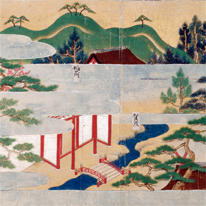Past Exhibitions
- Emaki of the Muromachi Period
- January 2, 2015 - February 8, 2015
Emaki are illustrated handscrolls usually containing narrative stories, legends, or histories. While some of the most famous emaki date to the Heian (794–1185) and Kamakura (1185–1333) periods, those produced during the Muromachi period (1392–1573) were painted by a wider range of artists for an audience representing a more expansive cross-section of Japanese society, from elites to commoners. Scrolls on the theme Legends of the Yūzū Nenbutsu Sect (Yūzū Nenbutsu engi) were made repeatedly under the patronage of the Ashikaga Shogunate in the early Muromachi period. Tales of the Monk Zegai (Zegaibō emaki) was written with young priests in mind. Tales of the Hidaka River (Hidakagawa zōshi), which turns the legend of Dōjō-ji—a staple of Noh and other performing arts—into a love story. Each of these handscrolls unfurls to reveal another world, depicted in grand scale.












